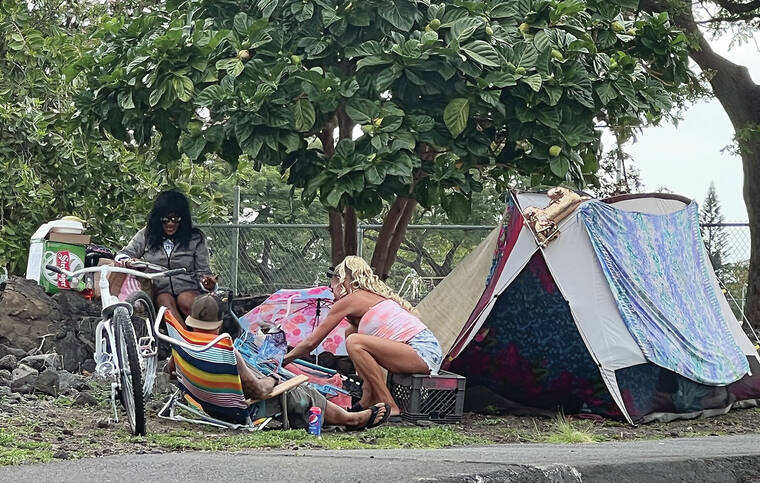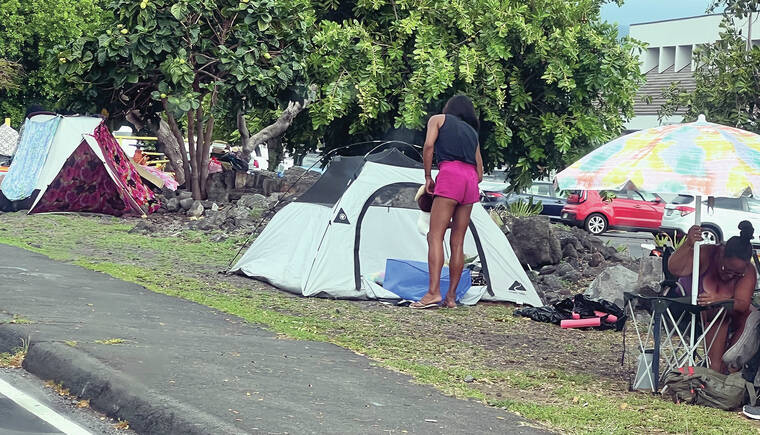Approximately one in three homeless individuals on Hawaii Island is considered chronically homeless, according to details gleaned from this year’s Point-In-Time Count.
A total of 837 homeless people were counted during this year’s count, with 300 identifying as “chronically homeless,” which mean having been continuously homeless for at least one year, according to the report released last week by Bridging the Gap Hawaii. Of the total homeless population, 314 were reported to have serious mental illness and 245 experienced chronic substance abuse.
The count conducted islandwide during January provides an estimate of homelessness on a specific night during the last ten days of January each year. The estimate adheres to the federal government’s definition of homelessness, which includes individuals and families residing in emergency shelters, transitional housing facilities, and people identified as sleeping and living in an unsheltered location on the night of the count.
The report is used to inform the community, elected officials, government agencies, and other stakeholders of the immediate homeless situation on the island. Counts are also conducted on Kauai, Maui and Oahu.
The count was last conducted in its entirety for Hawaii Island in 2020. Figures from the 2021 count did not include unsheltered individuals due to the COVID-19 pandemic
According to this year’s Hawaii Island Point-In-Time Count, unsheltered homelessness increased 6% (33 people) to 554 total individuals when compared to 2020. Unsheltered homelessness among individuals increased 14% (60 people) compared to 2020.
The total number of homeless families was 66, two fewer than 2020. There were 48 sheltered families identified, which was up 50% compared to 2021, the year during which family shelter capacity was reduced to meet Centers for Disease Control and Prevention (CDC) guidance amid the pandemic.
In addition, the amount of sheltered individuals increased to 283, up from 227 in 2021. The report states the increase was also the result of adding more shelter beds.
Despite the pandemic and reduced capacity over the past couple years, a 67% decrease in the number of unsheltered family households between 2018 and 2022 was realized, according to the report.
During the count, outreach volunteers made contact individuals and families in each district of the island. By district data was collected from 256 in South Hilo, 168 in North Kona, 56 in Puna, 23 in South Kona, 16 in North Hilo, 14 in South Kohala, 13 in Ka’u, 6 in Hamakua and two in North Kohala.
Meanwhile, Hawaii County’s plan for KukuiOla homeless village in Kailua-Kona has yet to break ground, nearly a year after work was expected to begin in May 2021.
The project was developed after then-Mayor Harry Kim ordered police to evict dozens of people illegally residing at Old Kona Airport Park in May 2017. Initial plans called for permanent housing for at least 100 of West Hawaii’s homeless residents to address the situation considered an emergency.
After being scaled down, the first phase of the project includes grading for entire property, access roadway, 16 units, community pavilion and kitchen, hygiene and laundry facilities, office space, dedicated safe parking and a green space.
The homeless village would be built on just under 36 acres at the corner of Ane Keohokalole Highway and Kealakehe Parkway in the vicinity of the West Hawaii Civic Center and Kealakehe High School.
Sharon Hirota, specialist with the county Office of Housing and Community Development on Friday said grading permits were recently obtained and the county is in discussion with the developer to start the project.
She added there is no completion date set yet.


